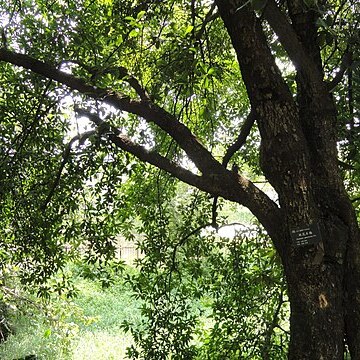Shrubs or small trees, evergreen, 6–10 m tall. Branchlets purplish brown or grayish brown when old, terete, densely yellow tomentose when young, glabrous when old, with many scattered lenticels; buds ovoid, 3–4 mm, pubescent, apex obtuse; scales dark brown. Petiole 2–4 cm, initially densely tomentose, later subglabrous; leaf blade oblong or lanceolate to oblanceolate, leathery, (5–)6–18 × 2.5–6 cm, lateral veins 12–20 pairs, abaxially densely yellow tomentose, later partly or wholly glabrescent, adaxially initially tomentose along midvein, glabrate, base obliquely cuneate to rounded, margin somewhat revolute, serrate, apex shortly acuminate. Compound corymbs terminal, densely glomerate, 5–10 × 6–12 cm, many flowered; rachis and pedicels densely yellow tomentose. Pedicel nearly absent or very short. Flowers fragrant, 4–5 mm in diam. Hypanthium cupular, 1–1.5 mm, abaxially densely yellow tomentose. Sepals erect, ovate, 1–1.5 mm, apex acute. Petals white, suborbicular, 2–2.5 mm in diam., adaxially pilose near base, base shortly clawed, apex obtuse. Stamens 20, nearly as long as petals. Styles 2, connate nearly to middle, not exceeding stamens. Fruit red, ovoid, 5–7 × 2.5–4 mm, glabrous. Fl. May–Jun, fr. Aug–Sep.
More
A shrub or small tree. It grows 6-10 m tall. It keeps its leaves throughout the year. The leaves are oblong to sword shaped and 6-18 cm long by 3-6 cm wide. There are many flowers in a group at the ends of the branches. The flowers have a scent and the petals are white. The fruit is red and oval. It is 5-7 mm long by 3-4 mm wide.


